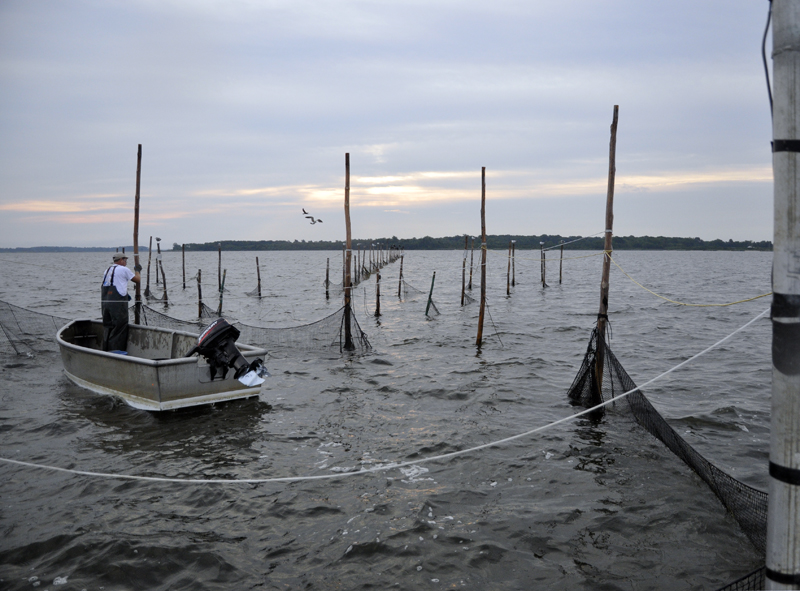The Striped Bass Program is responsible for monitoring the commercial striped bass fisheries in Maryland. Biologists collect samples during the summer/fall hook and line and pound net seasons and the winter gill net season in the Chesapeake Bay. Samples are also collected from the trawl and gill net seasons in the Atlantic Ocean. These samples are collected at commercial check stations and at pound nets. Results are reported to the United States Fish and Wildlife Service in the annual Federal Aid Report and to the Atlantic States Marine Fisheries Commission in the annual Compliance Report.
Commercial Check Station Sampling
 The purpose of this survey is to characterize the size and age structure of commercially harvested fish. All striped bass harvested in Maryland's commercial fisheries are required to pass through an approved Maryland Department of Natural Resources check station. The check stations are sampled several times each month with monthly sampling targets. The biologists collect data on length and weight. Scales are also removed from a sub-sample of fish to determine age. Ages are used to develop an age-length key for each fishery. This key is used to determine the number of fish harvested in the commercial fisheries at each age. It is also used to determine the mean length of the fish at each age.
The purpose of this survey is to characterize the size and age structure of commercially harvested fish. All striped bass harvested in Maryland's commercial fisheries are required to pass through an approved Maryland Department of Natural Resources check station. The check stations are sampled several times each month with monthly sampling targets. The biologists collect data on length and weight. Scales are also removed from a sub-sample of fish to determine age. Ages are used to develop an age-length key for each fishery. This key is used to determine the number of fish harvested in the commercial fisheries at each age. It is also used to determine the mean length of the fish at each age.
The hook and line and pound net seasons run from June 1 to December 31 and target resident/pre-migratory striped bass in the Chesapeake Bay. The Bay gill net fishery operates in January, February and December. These fisheries have a minimum size limit of 18 inches and a maximum size limit of 36 inches. Generally, the majority (~90%) of fish harvested in these fisheries are ages 3 to 7.
The Atlantic commercial fisheries are sampled similar to the Chesapeake Bay fisheries. The season runs from October 1st to May 31st. Striped bass are primarily caught as bycatch in the gill net and trawl spiny dogfish fishery. These fisheries have a minimum size limit of 24 inches and harvest larger fish than the Chesapeake Bay fisheries. Typically, the majority (~85%) of fish harvested in these fisheries are ages 7 to 11.
Commercial Pound Net Monitoring
 The purpose of this survey is to characterize the size and age structure of striped bass captured in pound nets and provides a good representation of the summer and fall striped bass population in the Bay. Sampling directly from the nets allows biologists to get a complete picture of all fish that encounter the nets, not just those that are commercially harvested. Pound nets are sampled several times per month in different areas of the Bay from June through November. Biologists collect data on length, external anomalies and scale samples. The scale samples are aged to develop an age-length key. The key is used to determine the number of fish caught in the pound nets at each age. It is also used to determine the mean length and mean weight of the fish at each age. In 2022, approximately 44% of the fish sampled from pound nets were 3 year old fish from the 2019 year-class. The above average 2017 and 2018 year-classes comprised 8% and 25% of the sample, respectively. The mean lengths for the 2019, 2018, and 2017 year-classes were 423 mm (16.7 in), 470 mm (18.5 in), and 574 mm (22.6 in), respectively.
The purpose of this survey is to characterize the size and age structure of striped bass captured in pound nets and provides a good representation of the summer and fall striped bass population in the Bay. Sampling directly from the nets allows biologists to get a complete picture of all fish that encounter the nets, not just those that are commercially harvested. Pound nets are sampled several times per month in different areas of the Bay from June through November. Biologists collect data on length, external anomalies and scale samples. The scale samples are aged to develop an age-length key. The key is used to determine the number of fish caught in the pound nets at each age. It is also used to determine the mean length and mean weight of the fish at each age. In 2022, approximately 44% of the fish sampled from pound nets were 3 year old fish from the 2019 year-class. The above average 2017 and 2018 year-classes comprised 8% and 25% of the sample, respectively. The mean lengths for the 2019, 2018, and 2017 year-classes were 423 mm (16.7 in), 470 mm (18.5 in), and 574 mm (22.6 in), respectively.